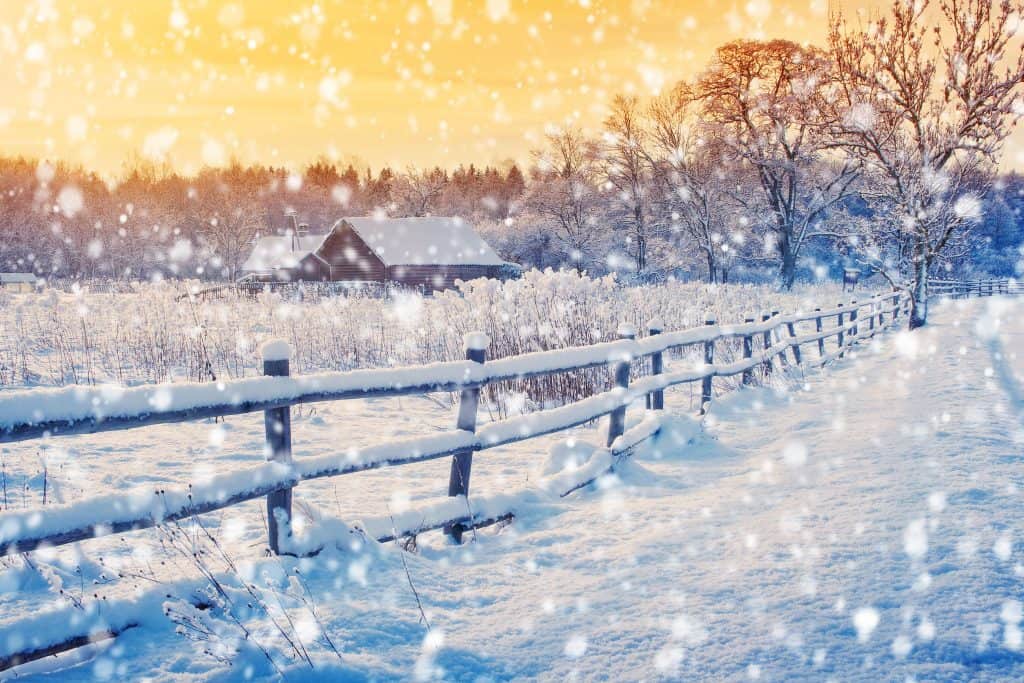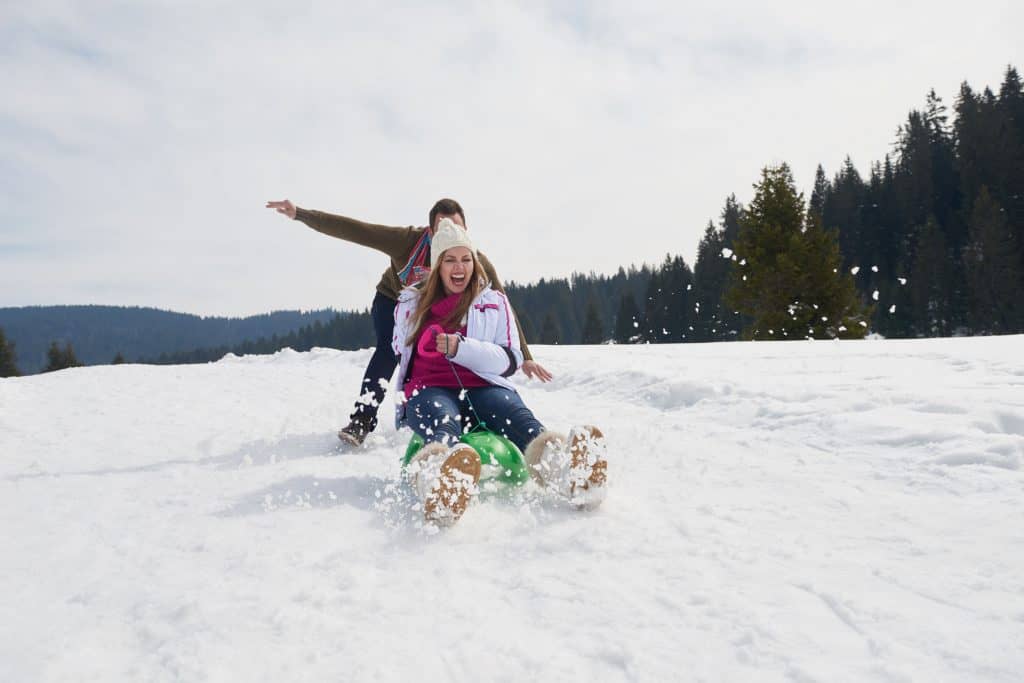
If you are looking out the window or checking the weather right now wondering when you can go sledding, this article is just for you! So instead of counting the flakes and hoping that there is enough to go sledding, read this article to be sure that there is.
Generally, 2-4 inches of snow is the amount of snow that is needed to go sledding. There are, however, many factors such as type of terrain, consistency of snow, style of the sled, and steepness of the sledding hill, that come into play.
These factors must also be taken into consideration before you hit the hills. Keep reading to find out if the current outdoor conditions are conducive for your sledding adventure or not!
What Makes for Good Sledding Conditions?
Anyone who has ever had the privilege to experience sledding knows that the obvious requirement for a good sledding outing is that there is snow. This is sledding 101! But so much more comes into play when deciding if the conditions are ideal and conducive to grab your sled and head out for some wintertime fun.
To be completely honest, there is no set rule or golden depth of snow by which a sledder can determine if his or her hill is sleddable. There are many other factors that one must take into consideration… no hill is exactly the same. That being said, the basic rule of thumb when it comes to sledding is this: If you can see the ground/vegetation, it is probably not a good idea to go sledding. As with most things in life, there are exceptions to this rule that will be mentioned later.
Sledding is heavily dependent on the weather. If the temperature is warm enough to melt all your snowmen, it is probably to warm to even produce snow. This can also render a hill to slushy to have an enjoyable ride down.
In addition to that, if the temperature is too cold, it can also affect sledding conditions. Too cold of weather can produce too light of snow or worse, it can make an existing sledding hill rock hard.
Nothing is worse than wiping out on a sledding hill that is as hard as concrete!
Keep in mind, the ideal temperature for sledding is 29 – 30 degrees Fahrenheit. At this temperature range, the snow isn’t too slushy and it isn’t frozen solid.
Snow Consistency
The type and consistency of snow plays a big part in knowing whether or not sledding hills are ready to be conquered. Temperature and weather conditions determine what type of snow you are going to get.
Heavy, Wet, and Sticky Snow
You only need 1-2 inches of this type of snow in order to go sledding!
If it is warmer out when it starts to snow, the snow becomes wetter and stickier than usual. The best way to describe this type of snow is that it is perfect for making snowmen and for packing snowballs.
Believe it or not, this type of snow is actually the best type to go sledding in. But why?
The answer can be found in physics! You don’t need as much of this type of snow to have a good time sledding due to its consistency. Heavier/wetter snow reduces friction by releasing more water when put under the pressure of the sled. Not only is this type of snow easier to sled in when there’s less of it, but it is also the ideal type of snow for sledding in general.
Lighter, Drier, and Fluffy Snow
This type of snow requires a little more depth in order to sled on. The best amount for this snow is around 4 inches.
This type of snow falls when the weather is colder outside. The flakes become so light and fluffy that they are powdery. This is the type of snow that makes a squeaky crunch noise when you step on it. Sadly, fluffy snow is not the most ideal type of snow to sled on, especially if it is under 4 inches.
If you do end up attempting sledding in light accumulation of these powdery flakes, I suggest packing it down and creating your own sledding run on the hill that you choose. Packing it down will minimize the friction and make your sledding hill more slippery.
This type of snow gets better the more you sled on it. You will notice that the sledding path you created at the beginning of your sledding outing gets better each time you sled on it.

How Does Terrain Affect Sledding?
The amount of snow needed to go sledding also heavily depends on the nature of the hill that you are choosing to sled on! As mentioned earlier, if you can see the ground/vegetation, it is probably not a good idea to go sledding.
Sledding hills that have thick and tall vegetation require a lot more snowflakes to pile up than hills that are made up of mowed backyard/park type grass.
If the hill that you are wanting to sled on has a lot of tall vegetation, I would suggest waiting to sled until this vegetation is fully covered, or until there is adequate space amongst the vegetation to make a sledding trail out of. On the other hand, if you are wanting to sled on a mowed grassy hill, you should wait until there are 1-4 inches on it (depending on the type of snow).
It is always important to know what you are sledding on. This not only an important determining factor in deciding whether there is enough snow to go sledding, but it is also something that can protect you while sledding.
If you are sledding on top of rocks or pokey vegetation, this can be quite hazardous (even when these things are covered up by the snow). Rocks can rip through your sled and can injure you. Be aware, especially if you are sledding on light/fluffy snow.
Visit our Winter/Snow Page for More Great Content!
Different Types of Sleds for Different Depths of Snow
The type of sled that you plan on using also affects the amount of snow that you need to hit the hills.
Inflatable Tubes
Inflatable tubes (especially the plastic pool-type ones) require barely any snow for you to go sledding. These tubes can easily fly down grassy hills that only have a light dusting of snow! These tubes are the exception to the 1-2 inch rule. They are, however, not good to use on the more heavily vegetated areas. These sleds have a tendency of popping easily so watch out for any rocky terrain.
Regular Plastic or Saucer Shaped Sleds
These types of sleds hold true to the 1-2 inch rule. They essentially require enough snow to use pressure and friction to their advantage. These sleds work best on grassy hills. If you are taking them to a hill that has taller vegetation, is suggest that you wait until the vegetation is fully immersed by the snow.
Toboggans and Traditional Skid-Type Sleds
Toboggans and sleds with runner or blades of the bottom of them require much more snow than the other two types listed above. On a grassy hill, you can expect these sleds to work well in a base of 2-4 inches of snow. Once again, for higher vegetative hills, wait until the snow has completely covered the rocks, plants, etc.
Tips for a Good Sledding Trip
After you have received a sufficient amount of snow to go sledding, you will want to follow these other suggestions in order to have the best sledding experience possible!
Make Sure You Check the Weather Forcast
The type of weather you go sledding in can greatly affect the quality and overall condition of the snow. It can also determine how comfortable you are as you sled as well.
You can often determine whether or not you will be able to plan on a future sledding trip based upon the weather and snow accumulation forecast. Meteorologists can actually predict how much snow may fall which will give you insight on sledding conditions.
In addition to that, warmer weather has a tendency to make the snow slushier which can mean that it may not be the best snow to sled in. On the flipside, really cold weather can freeze the snow and make it dangerous to sled on. This is why it is important to check on the weather.
Choose a Hill that is Void of Ice
Sledding on ice is very hazardous! I highly recommend steering clear of hills that get icy. Once again, check the weather, if it was a little bit warmer today, but is set to cool down overnight, the sledding hill that had some snow melt on it will turn into pure ice overnight.
Make Your Own Sledding Trails
The best way to have the best and fastest run sledding is to create your own downhill sledding trail first by packing the snow down. This is a technique that is perfect for implementing if you are planning on sledding in the snow that is over 6 inches deep.
When you make your own trail, you will have to make several trips down to get a good path. Going over the same spot over and over will allow you to go faster and further than before.
